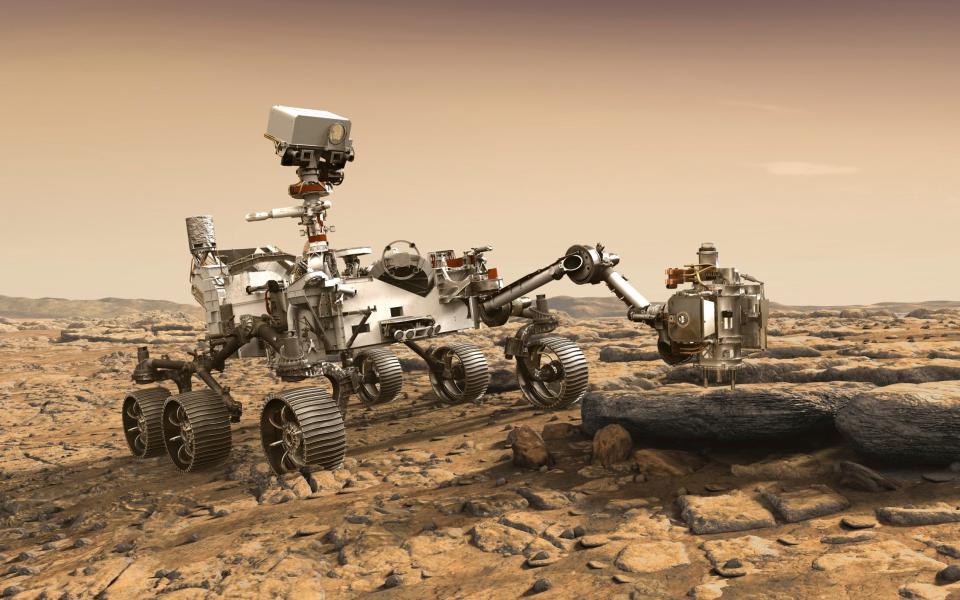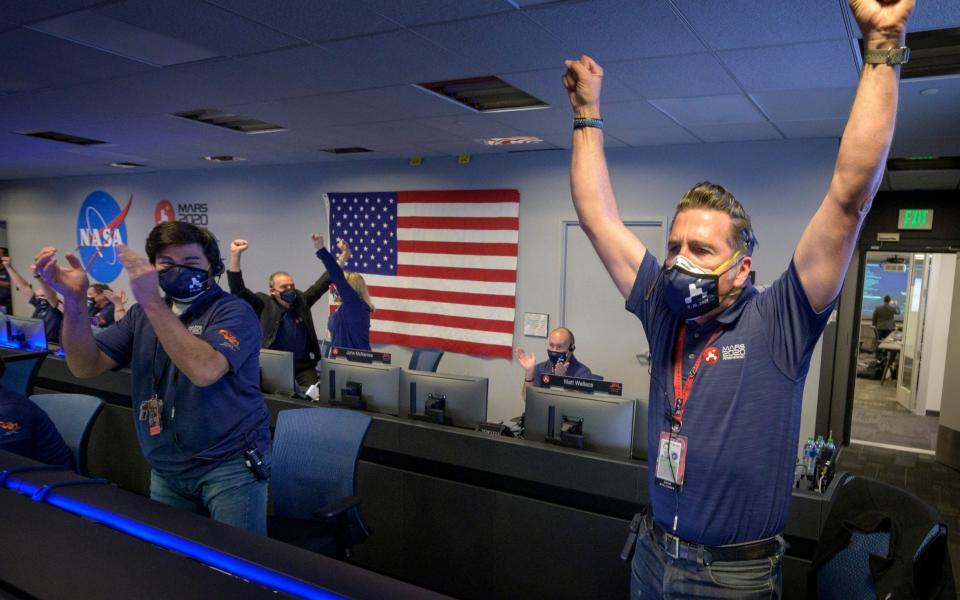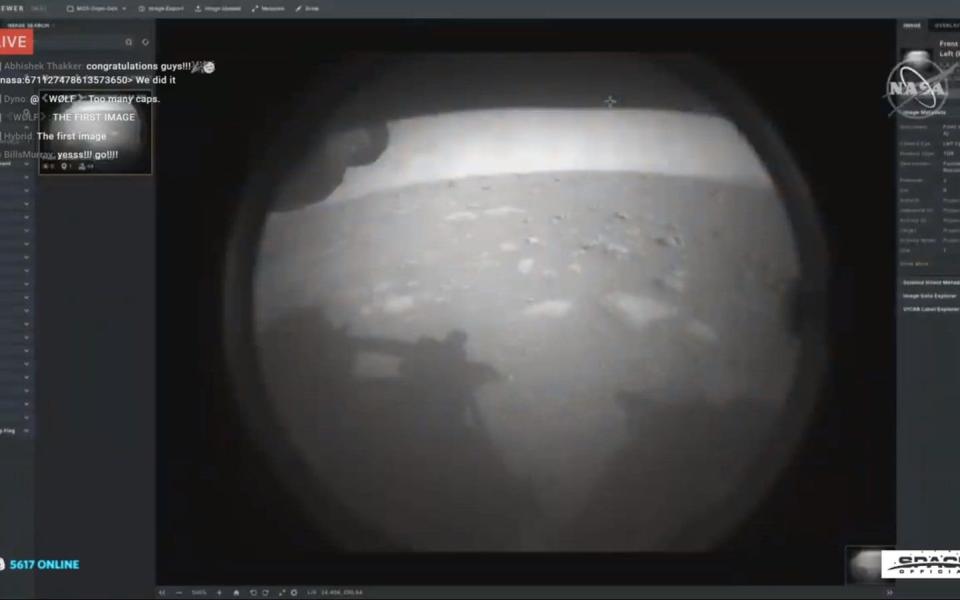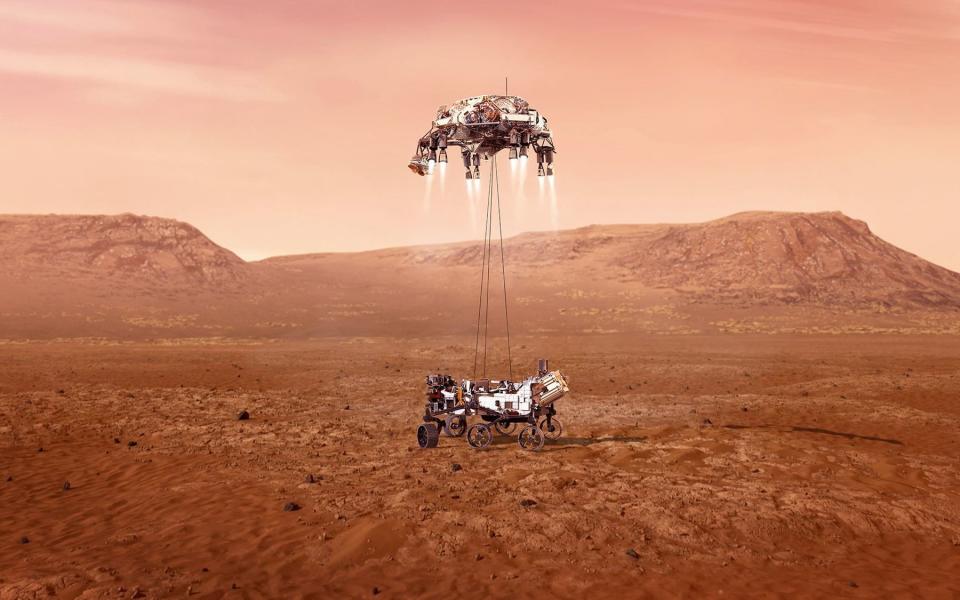Mars landing: Nasa Perseverance rover sends back first image as it pulls off daunting mission - watch live

Nasa's plutonium-powered Perseverance rover successfully touched down on Mars on Thursday night in an epic quest to search for signs of ancient life.
There was jubilation at mission control as the car-sized spacecraft sent back a "heartbeat tone" and grainy black and white images confirming it had reached the surface.
Watch: NASA's Perseverance rover lands safely on Mars
Scientists wearing masks fist-bumped and jumped in the air applauding. A Nasa spokesman said: "Touchdown is confirmed. Perseverance is continuing to transmit. This is so exciting. The team is beside themselves."
Perseverance - nicknamed "Percy" - was built as the most advanced astrobiology lab ever flown to another world, and its landing was the riskiest ever tried on the Red Planet.
Nasa chose as a target the Jezero crater, a potential deathtrap littered with boulders, ridges, cliffs and pits. The 28-mile wide crater was picked as a promising spot to find signs that life once existed.

Ground controllers at Nasa's Jet Propulsion Laboratory in Pasadena, California had watched helplessly and nervously, as Perseverance autonomously conducted its own approach to Mars. There was a nail-biting delay of over 11 minutes for signals from Mars to reach Earth.
Only four rovers had previously successfully set wheels down on the planet, all of them sent by Nasa.
Weather conditions for Perseverance's approach were favourable in the Martian northern hemisphere spring.
But, speaking before the landing attempt, Matt Wallace, the mission's deputy project manager, said: "This is one of the most difficult manoeuvres that we do in this business.
"And almost 50 per cent of the spacecraft that have been sent to the surface of Mars have failed."
Nasa scientists call the landing process on Mars the "seven minutes of terror".
Perseverance was launched in July and took seven months to cover 293 million miles to get to Mars. The mission cost $2.7 billion.
Images including video were being relayed from Perseverance to Earth through one of several satellites already in orbit around Mars.
Nasa scientists said it was the most ambitious of the nearly 20 US missions to Mars dating back to 1965. Perseverance, weighing a ton, was the biggest rover ever to be landed on the planet.
Watch: NASA astronaut rates 10 space movies based on how realistic they are
Perseverance, weighing a ton, was the biggest rover ever to be landed on the planet.
The Perseverance rover streaked into the Martian atmosphere six times as fast as a speeding bullet.
The plan for landing Nasa's six-wheeled rover depended partly on deploying a giant, supersonic 70ft-wide parachute to slow its fall.
Asked to name the single most critical moment Al Chen, the head of the descent and landing team, said: "Obviously there's a lot of concentrated risk in supersonic parachute opening."
Around 100 people at a British company in Tiverton, Devon worked on making the special fabric for the parachute.
Before the landing Peter Hill, a director at Heathcoat Fabrics, told Business Live: "I’m just hoping that everything goes to plan. It would be amazing for everyone that worked on this if life was found on Mars."
He added: "It's only when you’re watching footage coming back from space that you get really nervous, especially from the moment of deployment until the point that it [the parachute] is actually working."

Scientists believe that, around 3.5 billion years ago the Jezero crater - where Perseverance was sent - was home to a river that flowed into a lake and deposited sediment in a fan-shaped delta. They hoped it could harbour fossilised microorganisms the rover could find evidence of.
However, before the landing, there were some nerves about Jezero crater as a destination. Mr Chen said: "It's full of the stuff that scientists want to see but stuff that I don't want to land on."
Twenty seconds after the deployment of the parachute Nasa's landing plan called for a heat shield to be jettisoned. The parachute was only expected to slow Perseverance's speed to about 200mph.
It was then designed to be brought to the ground by a rocket-powered "sky crane". The sky crane's role was to carry the rover on tethers, gently descending to the surface and depositing it, before cutting the cords, flying off and crashing a safe distance away.
Watch: How an immigrant farmworker beat the odds to become a NASA astronaut
Perseverance was designed to move at a speed of up to 0.1mph along the surface, blistering by Mars rover standards. Its mission was to collect dozens of samples of ancient sediments from Martian rock - the first such specimens ever collected by humankind from another planet - and store them in cigar-shaped tubes.
Nasa's ambitious plan called for retrieving the specimens on future missions in the next decade, and returning them to Earth so they could be properly studied
Perseverance was fitted with 19 cameras, allowing it to film its own landing. It was also built with two microphones designed to record the Martian soundscape for the first time.
The craft was due to conduct an experiment converting carbon dioxide in the Martian atmosphere into small amounts of pure oxygen.
Nasa said doing so would prove invaluable for future life support on Mars, and for making rocket propellant to fly astronauts home.
The rover was also carrying with it a miniature helicopter called Ingenuity, which was designed to make the first aircraft flight on another planet.
Mary Voytek, head of Nasa's astrobiology programme. said: "We astrobiologists have been dreaming about this mission for decades."
09:14 PM
Rover has 19 cameras
The rover is also equipped with 19 cameras and two microphones, many of them turned on during descent.
Among the never-before-seen views Nasa intends to send back in the next couple days: the enormous supersonic parachute billowing open and the ground getting closer.

09:03 PM
First image from the red planet
— NASA's Perseverance Mars Rover (@NASAPersevere) February 18, 2021Hello, world. My first look at my forever home. #CountdownToMars pic.twitter.com/dkM9jE9I6X
08:57 PM
Touchdown confirmed!
The rover has successfully landed on the surface of Mars. The Perseverance rover will now begin searching for rock samples that could answer whether life ever existed on the red planet.
The landing marks the riskiest step yet in the quest to learn more about Mars. The rover weighs a ton, making it the biggest rover ever to be landed on the planet.
08:56 PM
Parachutes deployed
Perseverance’s 70-ft parachute has successfully unfurled. There were cheers at Nasa's mission control as the rover transmitted confirmation that the parachute had deployed.
08:54 PM
Rover enters atmosphere
Nasa has confirmed the Perseverance rover has entered the Martian atmosphere on its way to landing on the planet.
"We have confirmation of entry interface" said operations lead Swati Mohan.
The risky, autonomously guided landing phase lasts about seven minutes, and it takes more than 11 minutes for a radio signal to reach Earth.
That means the rover is already on the surface, but it is not yet known whether it crashed or landed successfully.
Before touching down, the rover will undergo an important phase during which many critical events will have to take place in order for it to land safely.
This phase, known as entry, descent, and landing (EDL), is the shortest and most intense of the Mars 2020 mission.
It begins when the spacecraft reaches the top of the Martian atmosphere, travelling at nearly 12,500 miles per hour and ends about seven minutes later, with Perseverance stationary on the planet's surface.
08:51 PM
Europe's Space Agency assisting with mission
Nasa is teaming up with the European Space Agency to bring the rocks home. Perseverance's mission alone costs nearly $3 billion.
The only way to confirm – or rule out – signs of past life is to analyse the samples in the world's best labs. Instruments small enough to be sent to Mars wouldn't have the necessary precision.
"The Mars sample return project is probably the most challenging thing we've ever attempted within Nasa," said planetary science director Lori Glaze, "and we don't do any of these things alone."
08:50 PM
'The rover is in charge'
Moments before the landing procedure commenced Nasa scientists sat at mission control with masks on and socially distanced, listening to tones broadcast by Perseverance.
A Nasa spokesman said: "It's telling us it's alive. The rover's in charge, it's doing what we taught it to do. "There's a lot that can go wrong. It's a bit of a gamle. We hope we have stacked the deck and loaded the dice."
"Now we wait," another Nasa commentator said.
08:48 PM
Perseverance entering Martian atmosphere
Perseverance will enter the top of the Martian atmosphere within minutes and is expected to touch down at around 3.55 pm ET, 8.55pm in the UK. The time delay involved in communicating with Earth means that the spacecraft has to accomplish this conduct the landing all by itself.
08:43 PM
What will today's mission accomplish?
Percy, as it is nicknamed, was designed to drill down with its 7-ft arm and collect rock samples that might hold signs of bygone microscopic life (see image below).

If all goes to plan, it will collect three to four dozen chalk-size samples to be sealed in tubes and set aside on Mars to be retrieved by a fetch rover and brought homeward by another rocket ship, with the goal of getting them back to Earth as early as 2031.
Scientists hope the mission will help to answer one of the central questions of theology, philosophy and space exploration.
"Are we alone in this sort of vast cosmic desert, just flying through space, or is life much more common? Does it just emerge whenever and wherever the conditions are ripe?" said deputy project scientist Ken Williford. "Big, basic questions, and we don't know the answers yet. So we're really on the verge of being able to potentially answer these enormous questions."
08:23 PM
Devon company that made WW2 parachutes to land rover
The Telegraph's Olivia Rudgard reports on the Devon company that made parachutes for the Second World War which will contribute to tonight's landing on Mars.
Tiverton-based Heathcoat Fabrics, founded by a family of inventors who began by working with lace and silk in the 19th century, now makes state-of-the-art fabric for space companies and Nasa, as well as for military and energy clients.
Director Peter Hill said he is "a bit nervous" for the parachute's big moment. Read our news story for all the details.
08:11 PM
Why is this so risky?
Percy is the size of a Mini Cooper and will aim to pull off Nasa's smallest and trickiest target yet: a 5-by-4-mile strip on an ancient river delta full of pits, cliffs and fields of rock.
John Grunsfeld, former astronaut and former lead for science at Nasa, explains why today's mission is so daunting.
Mr Grunsfeld led Nasa's science division during the Curiosity rover's landing in 2012, and during the time that development of the Perseverance mission was initiated.
— John Grunsfeld (@SciAstro) February 18, 2021#CuriosityRover landed successfully, but don’t think landing on #Mars is routine. This really scary. The hard work of the @NASAPersevere @NASAJPL team over the last 8 years is on the line now. I have confidence they’ve done all they can to set up #NASAPersevere for success.
Mars has proved a treacherous place: In the span of less than three months in 1999, a US spacecraft was destroyed upon entering orbit because engineers mixed up metric and imperial units, and an American lander crashed on Mars after its engines cut out prematurely.
07:48 PM
Third trip to Mars this week
The landing of the six-wheeled vehicle would mark the third visit to Mars in just over a week. Two spacecraft from the United Arab Emirates and China swung into orbit around the planet on successive days last week.
All three missions lifted off in July to take advantage of the close alignment of Earth and Mars, travelling some 300 million miles in nearly seven months.
Perseverance, the biggest, most advanced rover ever sent by Nasa, stood to become the ninth spacecraft to successfully land on Mars, every one of them from the US.
China's spacecraft includes a smaller rover that also will be seeking evidence of life, if it makes it safely down from orbit in May or June.
07:41 PM
Perseverance operating alone
Perseverance, or Percy, has now been set to operate on its own. The rover has pre-programmed landing instructions to, hopefully, allow it to land itself safely on Mars.
During the descent, the spacecraft will send updates on how it is doing.
Percy is now less than 10,000 miles, from its landing site inside Jezero Crater. The spacecraft is flying at about 7,100 mph relative to Mars. Martian gravity will tug the rover to a maximum speed of about 12,000 mph just before entering the atmosphere.
07:28 PM
'Seven minutes of terror'
Perseverance's descent has been described by Nasa as "seven minutes of terror," in which flight controllers can only watch helplessly.
The preprogrammed spacecraft was designed to hit the Martian atmosphere at 12,100 mph (19,500 kph), then use a parachute to slow it down and a rocket-steered platform known as a sky crane to lower the rover the rest of the way to the surface (see image below).

07:24 PM
We're off!
Nasa has begun streaming as it prepares for the most difficult landing ever attempted on Mars.
In about 90 minutes, Nasa's plutonium-powered Perseverance rover will be attempting to land on Mars in an epic quest to search for signs of ancient life.
Percy, as the Rover has been nicknamed, has its own Twitter account from which the mission team will be sharing updates from the perspective of the rover.
— NASA's Perseverance Mars Rover (@NASAPersevere) February 18, 2021A preview of what’s to come in just a couple of hours. Once I get this part behind me, I’ll finally be able to get to work. Can’t wait. #CountdownToMars pic.twitter.com/KDrOzNFats
07:00 PM
Weather conditions update
Weather conditions so far appear favourable in the Martian northern hemisphere spring, but nothing is taken for granted.
"This is one of the most difficult manoeuvre that we do in this business, and almost 50 percent of the spacecraft that had been sent to the surface of Mars have failed," Matt Wallace, the mission's deputy project manager said.

 Yahoo News
Yahoo News 
